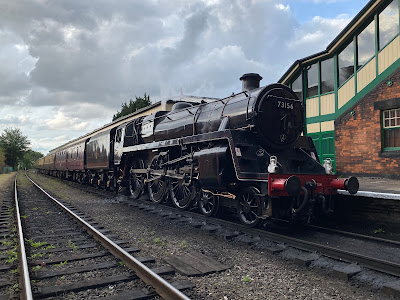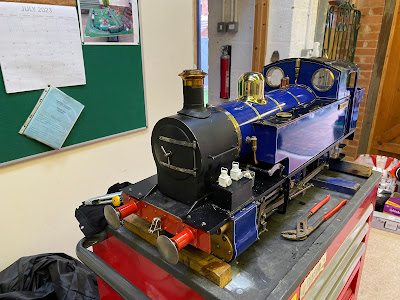Evening all. Just nine days after the last time I was on it, today my afternoon firing turn at the Great Central Railway saw me firing the beautiful 1956-built BR Standard 5 once again. My booked sign on was 12:30, ready to work the 14:00 passenger train with driver Alan. Having signed in and read the notices I wandered up to the picnic benches at the north of Loughborough's island platform to have my lunch before the engine turned up. Unsurprisingly, the station cat Onslaught (who was snoozing seconds before my lunch bag opened) appeared on my table and petitioned me for food. She is a persuasive type and is the friendliest of moggies when you've got food in your grasp. For those that don't know, Onslaught is the station mascot and, together with her frenemy Dreadnought, she lives in the ops hut and can often be seen sauntering around the station. She is quite often the subject of photographs...
Right on time at 13:20, 73156 whistled into Loughborough's platform 1 and came to a stand with a five coach train. As the engine ran round via the north points, myself and Alan took over from the morning crew. The engine had 200psi on the clock, a nice quiet fire and 3/4 of a glass of water in the frames so there was nothing to complain about. We still had just over 30 minutes until our departure when we took over so there was no rush. Once coupled on to the waiting stock at the south end I started to pull some coal (or dust) down in the tender. The tender was a mixed bag of all sorts but the majority was Welsh dust from Ffos-Y-Fran. This coal is so soft now that it literally turns to dust before your very eyes. Indeed, most of this single return trip had to be fired on slack but, with a good engine and good dampers, we managed to keep everything under control and had no trouble with steam or clinker whilst on the road.
The engine steamed beautifully throughout our round trip and as always was a joy to be on. Here she is waiting time at Rothley with the up starter signal for the Leicester section in the 'on' position. We were waiting for 9F No92214 to come down the hill from Thurcaston with the returning Elizabethan Sunday diner...
Once at Leicester North we had a few footplate visitors before we ran round. Coupled on, lamps changed and fire remade, off we went back to Loughborough. The run back was pleasant as well and I managed to run the engine down nicely for the approach to the terminus where we would soon be on shed disposing. The 9F would be taking over the stock for the final train of the day at 16:00 and so we had to wait until she had cleared the shed road before we were signalled to set back. Here, the lovely 73156 waits patiently for the huge 9F to clear the road for her (again)...
Back at the shed on no2 road, we came to a stand alongside a cold 78018. The Great Central seems to be alive with Standards at the minute, although the lovely Hall is now waiting in the wings for her return to steam in the coming weeks! Here, the BR 5 stands over no2 pit as I prepared to check/empty the smokebox...
All was well in the front end (the self cleaning gear in there gets rid of 95% of the ash that would usually settle in there). Driver Alan then went underneath to give the engine a quick check over before I soaked and emptied the ashpan. Again, with this superior Riddles machine, ashing out is a doddle. Pan done, fire quietened, baffle plate removed and boiler filled up, the job was done! The 5 was left simmering away to herself with a topped up boiler and 150psi on the clock. We always leave a light covering of fire on the grate to keep them warm as you don't want any thermic shocks in a hot firebox. I must thank Alan for another great turn on the lovely 73156. You can read about our exploit with her last week on the diner by clicking here. Cheers all, Sam...
Please note any views or opinions expressed in this blog are merely personal and do not in any way represent the views or opinions of any other person, group or organisation.









































.jpg)





